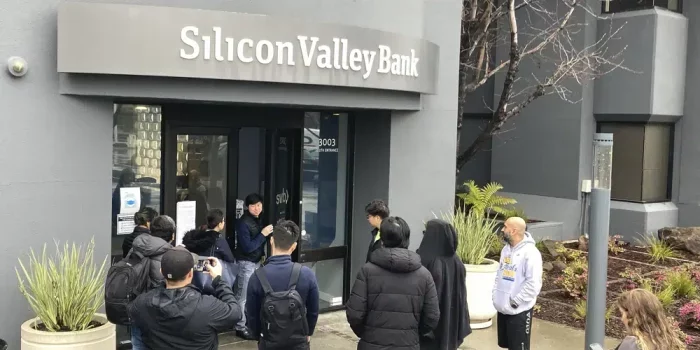(Headline USA) Regulators rushed Friday to seize the assets of one of Silicon Valley’s top banks, marking the largest failure of a U.S. financial institution since the height of the financial crisis almost 15 years ago.
Silicon Valley Bank, the nation’s 16th-largest bank, failed after depositors hurried to withdraw money this week amid anxiety over the bank’s health. It was the second biggest bank failure in U.S. history after the collapse of Washington Mutual in 2008.
The bank served mostly technology workers and venture capital-backed companies, including some of the industry’s best-known brands.
“This is an extinction-level event for startups,” said Garry Tan, CEO of Y Combinator, a startup incubator that launched Airbnb, DoorDash and Dropbox and has referred hundreds of entrepreneurs to the bank.
“I literally have been hearing from hundreds of our founders asking for help on how they can get through this. They are asking, ‘Do I have to furlough my workers?’”
Nearly half of the U.S. technology and health care companies that went public last year after getting early funding from venture capital firms were Silicon Valley Bank customers, according to the bank’s website.
The bank also boasted of its connections to leading tech companies such as Shopify, ZipRecruiter and one of the top venture capital firms, Andreesson Horowitz.
Tan estimated that nearly one-third of Y Combinator’s startups will not be able to make payroll at some point in the next month if they cannot access their money.
Internet TV provider Roku was among casualties of the bank collapse. It said in a regulatory filing Friday that about 26% of its cash — $487 million — was deposited at Silicon Valley Bank.
Roku said its deposits with SVB were largely uninsured and it didn’t know “to what extent” it would be able to recover them.
As part of the seizure, California bank regulators and the FDIC transferred the bank’s assets to a newly created institution — the Deposit Insurance Bank of Santa Clara. The new bank will start paying out insured deposits on Monday. Then the FDIC and California regulators plan to sell off the rest of the assets to make other depositors whole.
There was unease in the banking sector all week, with shares tumbling by double digits. Then news of Silicon Valley Bank’s distress pushed shares of almost all financial institutions even lower Friday.
The failure arrived with incredible speed. Some industry analysts suggested Friday that the bank was still a good company and a wise investment. Meanwhile, Silicon Valley Bank executives were trying to raise capital and find additional investors. However, trading in the bank’s shares was halted before stock market’s opening bell due to extreme volatility.
Shortly before noon, the FDIC moved to shutter the bank. Notably, the agency did not wait until the close of business, which is the typical approach. The FDIC could not immediately find a buyer for the bank’s assets, signaling how fast depositors cashed out.
At the time of its failure, Silicon Valley Bank, which is based in Santa Clara, California, had $209 billion in total assets, the FDIC said. It was unclear how many of its deposits were above the $250,000 insurance limit, but previous regulatory reports showed that lots of accounts exceeded that amount.
The bank announced plans Thursday to raise up to $1.75 billion in order to strengthen its capital position. That sent investors scurrying and shares plunged 60%. They tumbled lower still Friday before the opening of the Nasdaq, where the bank’s shares were traded.
As its name implied, Silicon Valley Bank was a major financial conduit between the technology sector, startups and tech workers. It was seen as good business sense to develop a relationship with the bank if a startup founder wanted to find new investors or go public.
Conceived in 1983 by co-founders Bill Biggerstaff and Robert Medearis during a poker game, the bank leveraged its Silicon Valley roots to become a financial cornerstone in the tech industry.
Bill Tyler, the CEO of TWG Supply in Grapevine, Texas, said he first realized something was wrong when his employees texted him at 6:30 a.m. Friday to complain that they did not receive their paychecks.
TWG, which has just 18 employees, had already sent the money for the checks to a payroll services provider that used Silicon Valley Bank. Tyler was scrambling to figure out how to pay his workers.
“We’re waiting on roughly $27,000,” he said. “It’s already not a timely payment. It’s already an uncomfortable position. I don’t want to ask any employees, to say, ‘Hey, can you wait until mid-next week to get paid?’”
Silicon Valley Bank’s ties to the tech sector added to its troubles. Technology stocks have been hit hard in the past 18 months after a growth surge during the pandemic, and layoffs have spread throughout the industry. Venture capital funding has also been declining.
At the same time, the bank was hit hard by the Federal Reserve’s fight against inflation and an aggressive series of interest rate hikes to cool the economy.
As the Fed raises its benchmark interest rate, the value of generally stable bonds starts to fall. That is not typically a problem, but when depositors grow anxious and begin withdrawing their money, banks sometimes have to sell those bonds before they mature to cover the exodus.
That is exactly what happened to Silicon Valley Bank, which had to sell $21 billion in highly liquid assets to cover the sudden withdrawals. It took a $1.8 billion loss on that sale.
Ashley Tyrner, CEO of FarmboxRx, said she had spoken to several friends whose businesses are backed by venture capital. She described them as being “beside themselves” over the bank’s failure. Tyrner’s chief operating officer tried to withdraw her company’s funds on Thursday but failed to do so in time.
“One friend said they couldn’t make payroll today and cried when they had to inform 200 employees because of this issue,” Tyrner said.
Adapted from reporting by the Associated Press

